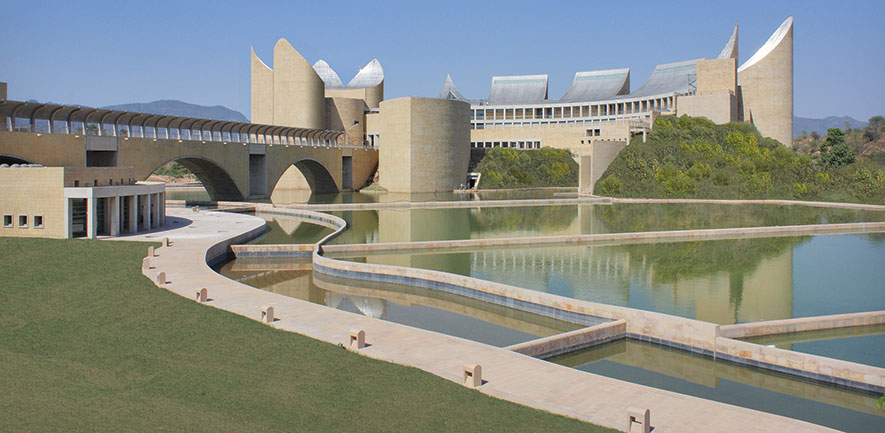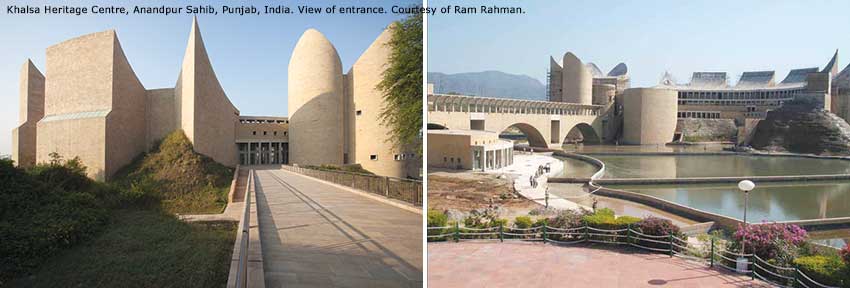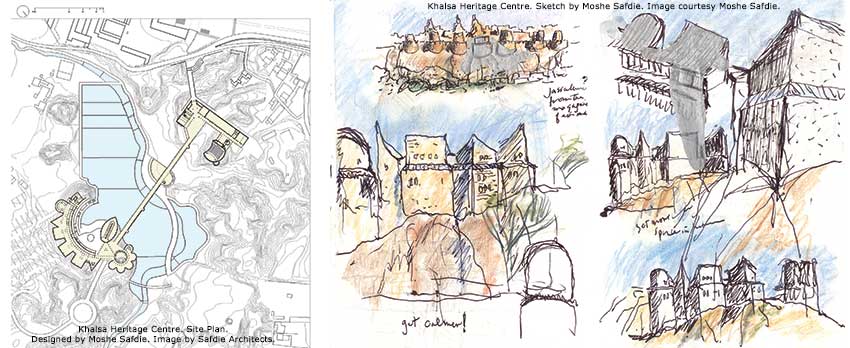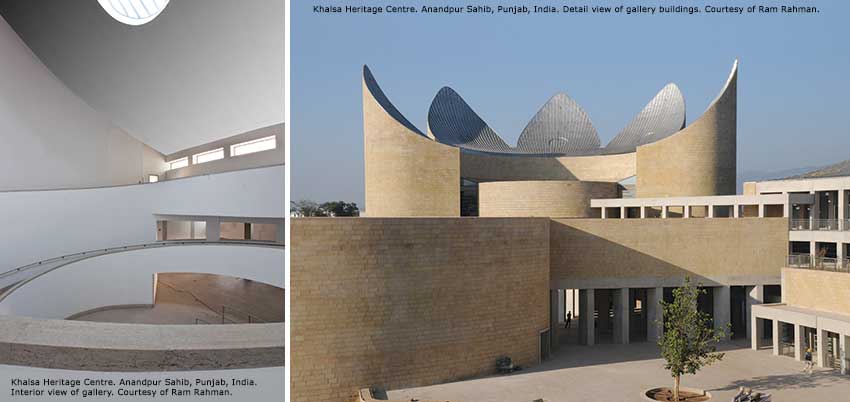
The Virasat-e-Khalsa Heritage Centre, a mammoth museum chronicling Sikh history was recently inaugurated in the land of Sikh warriors, Anandpur Sahib by Chief Minister of Punjab in the presence of Boston-based designer of the complex, Moshe Safdie, who is known for creating the famous Holocaust Memorial Museum in Jerusalem.

The classy complex, which is expected to draw international attention, has come up in rugged surroundings but with water bodies of extraordinary beauty, and reflect the surrounding hillocks, lend the complex an astonishing degree of serenity. Sprawl over 65-acre, the complex is deeply rooted in its surrounding landscape and resonating with regional architecture, seemingly rises from nearby sand cliffs. Clad with local sandstone and evoking the fortress cities of Rajasthan, Gwalior and Punjab, the Centre acknowledges the Sikhs' history as celebrated warriors. The upwardly curving roofs of the museum's tower-like galleries are covered in stainless steel, designed in counterpoint to the rich tradition of gold domes that crown sacred Sikh buildings as the Golden Temple in Amritsar. The project is said to be the largest contemporary heritage complex ever conceived in India and provides a delightful audio-visual experience unlike anything one has seen in Indian museums.

The museum campus is composed of two functionally integrated sets of buildings. The western complex, forming a gateway to Anandpur Sahib, houses exhibition galleries; a two-level library centered around a grand reading room overlooks water garden; a facility for storing rare archival materials and a 400-seat auditorium. A 540-foot bridge from the western complex crossed a seven-acre network of reflecting pools, providing access to the eastern complex which houses permanent exhibitions presenting Sikh history, religion, and culture.
Arranged in group of five, the galleries reference the five virtues of Sikh religion. The symbolic themes of earth and sky, mass and lightness and depth and ascension are represented by the museum's sandstone towers and reflective silver roofs and are further echoed inside the museum's galleries.
The delightful experience begins at the Boat-shaped building 'Punj Paani' - the first gallery depicting the past and the present of Punjab, as seen in its villages and towns. The inside walls of the towering boat-shaped building have multiple colourful panels to create a three-dimensional effect, every inch hand-painted to perfection. The building also houses the largest hand-painted mural in the world, which uses a staggering 24,000 metres of fibre optics to illuminate it to depict Diwali.

As one will walk through the ramp encircling 'Punj Paani, he will find that with the help of sound, music and other visual manipulations, the entire cycle of a year is recreated within a span of just eight minutes. The vibrant colors then give way to a subdued, star studded night with a tower of light at the centre, which symbolizes the emergence of 'Ek Onkar', illuminated, pure and eternal. From here begins the journey of the evolution of the Panth with the birth of Guru Nanak Dev. The experience is enriched by the auto-trigger audio guides, available in English, Hindi and Punjabi. 'Auto-trigger' implies that as you walk into any gallery and the audio guide plays content specific to the area. In the 'Five Crescent Building', the tone and tenor of the colors and sound becomes more militant and depict the struggle and sacrifices made by the last five Gurus to establish the Panth.
The 15 galleries which are completed so far out of 25, cover an area of 650,000 square feet. Ten more will be completed subsequently. The second phase of the complex, for which work is still going on, is expected to show the growth of Khalsa over the last 300 years, culminating in the partition of Punjab.

Safdie and his associate architect, Ashok Dhawan of New Delhi, worked closely with the exhibition designer, Amardeep Belh of Design Habit in New Delhi, to achieve a successful integration of architecture and display. According to the interior designer of the building, Mr. Amardeep Behl, "It took us almost three and half years to complete the interiors which include paintings, murals and around 400 artist were involved in it including designers."
Moshe Safdie was commissioned to design the Khalsa Heritage Centre in 1997, after the chief minister of the Punjab visited the Children's Holocaust Memorial at Yad Vashem, the Safdie-designed Holocaust memorial in Jerusalem. As the Centre evolved, Safdie was able to renew a long, close relationship with India that had begun in the 1960s with his work on Louis Kahn's Indian Institute of Management school at Ahmedabad, Gujarat.
















